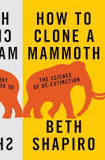 I just finished an interesting book with a provocative title. How to Clone a Mammoth, by Beth Shapiro, is a readable, sober assessment of de-extinction, the idea of bringing back extinct species through a variety of techniques. She defines very clearly at the outset that the purpose of de-extinction is ecological – to restore critical / desired organism/organism or organism/abiotic environment interactions in ecosystems. It is, in other words, a potentially powerful tool in helping to solve problems with biodiversity. It is happening now, whether you approve or not, and it’s both extremely challenging and very expensive. Shapiro recounts historical efforts and societal reactions, expeditions, and lab work in great detail. She does a great job of beginning with the big picture, and then getting down into the weeds of genetic engineering. For anyone who’s captivated by the notion of glimpsing species that have vanished from the Earth, or anyone interested in biodiversity conservation, or anyone interested in molecular genetics’ cutting edge, this is a book worth reading. It’s a great choice for a companion to other contemporary works on environmental degradation, such as Elizabeth Kolbert’s The Sixth Extinction, or Gaia Vince’s Adventures in the Anthropocene. Particularly fascinating to me were the lattermost two chapters, that examine the legal and ethical ramifications of proceeding with de-extinction efforts. Are de-extincted species GMOs? Invasives? Endangered? All three? When is it the right choice to “re-extinct” a de-extinction that has gone awry? Shapiro has written a book that lacks hyperbole, and addresses these questions in clear prose. Her experience working in the field and teaching about it has resulted in an informative survey of the state of the art in this fascinating cross-disciplinary field.
I just finished an interesting book with a provocative title. How to Clone a Mammoth, by Beth Shapiro, is a readable, sober assessment of de-extinction, the idea of bringing back extinct species through a variety of techniques. She defines very clearly at the outset that the purpose of de-extinction is ecological – to restore critical / desired organism/organism or organism/abiotic environment interactions in ecosystems. It is, in other words, a potentially powerful tool in helping to solve problems with biodiversity. It is happening now, whether you approve or not, and it’s both extremely challenging and very expensive. Shapiro recounts historical efforts and societal reactions, expeditions, and lab work in great detail. She does a great job of beginning with the big picture, and then getting down into the weeds of genetic engineering. For anyone who’s captivated by the notion of glimpsing species that have vanished from the Earth, or anyone interested in biodiversity conservation, or anyone interested in molecular genetics’ cutting edge, this is a book worth reading. It’s a great choice for a companion to other contemporary works on environmental degradation, such as Elizabeth Kolbert’s The Sixth Extinction, or Gaia Vince’s Adventures in the Anthropocene. Particularly fascinating to me were the lattermost two chapters, that examine the legal and ethical ramifications of proceeding with de-extinction efforts. Are de-extincted species GMOs? Invasives? Endangered? All three? When is it the right choice to “re-extinct” a de-extinction that has gone awry? Shapiro has written a book that lacks hyperbole, and addresses these questions in clear prose. Her experience working in the field and teaching about it has resulted in an informative survey of the state of the art in this fascinating cross-disciplinary field.

I think a persuasive argument can be made that artificial intelligence and genetic engineering are the two most powerful emerging technologies in the hands of human beings. Both have the potential to exterminate us, both have the potential to improve our lives beyond what we can imagine.
Take basic physics, chemistry, and nuclear physics as examples. All three were revolutionary in their impact on human society. All three were also weaponized. And you can’t just not do it. If we see that it can be done, others will see it too. There is no escape from that future, only attempting to manage it.
Back to the subject, and not having read the book, I’m not sure I see a benefit to bringing back any particular species other than the ‘cool factor’ as in dinosaurs in Jurassic Park. What does a mammoth add to a biosphere finding a new post-glacial kill-off equilibrium? How do you go about making these decisions? Do we bring back predators? Saber-tooth cats roaming your state parks anyone? Who’s responsible for the inevitable deaths? Lots of question in front of us, I agree. And sooner than we think.
The book addresses your “benefit” question. Shapiro dismisses “cool factor” as reasonable – in her view, the only plausible justification for de-extinction is replacing the ecosystem services that the organism once provided. She addresses some of the legal ramifications you raise, too – sounds like you might enjoy considering some of her arguments in the book.